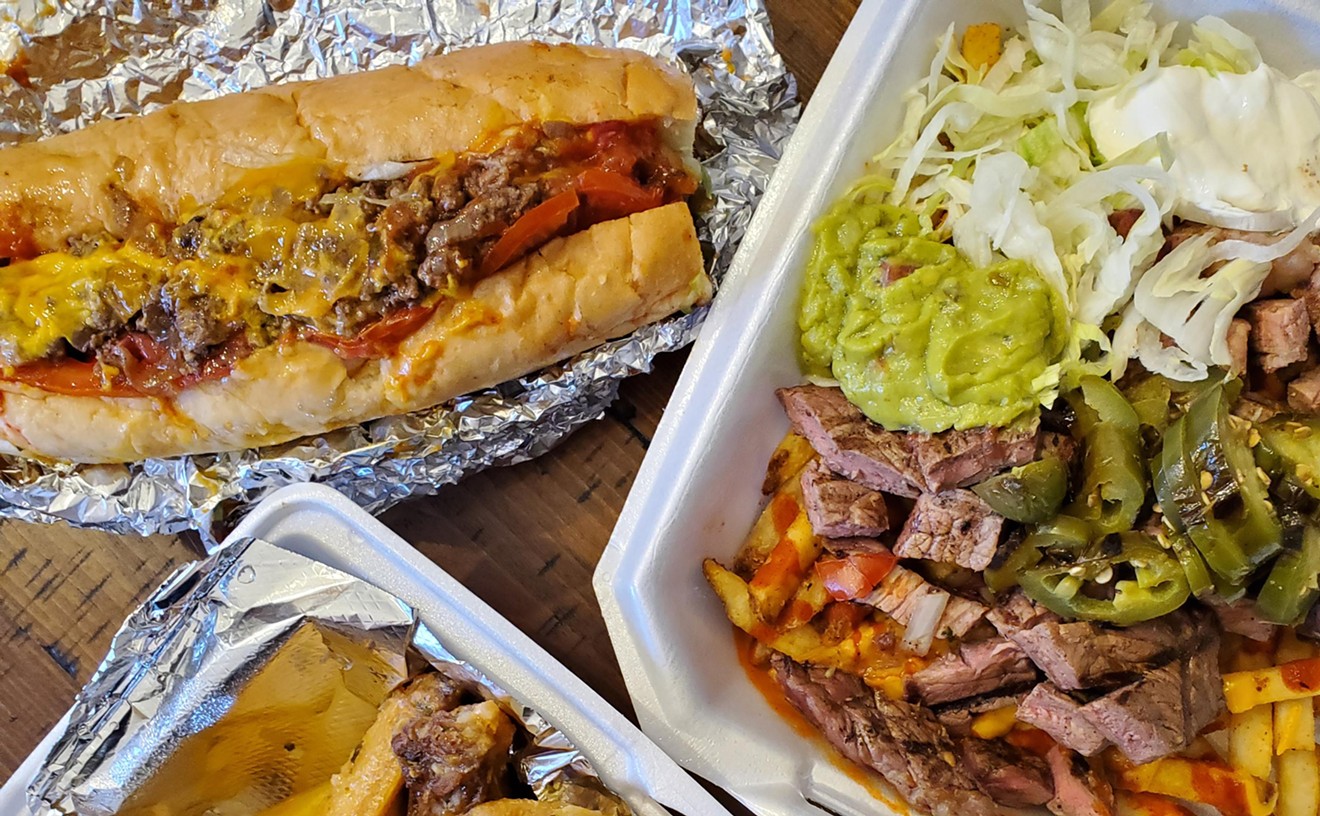I get asked that a lot. Most often by my wife.
"No, I mean seriously, Jay. Whole fish and sea bugs and chicken ass -- why?"
Because they're good, I tell her (or anyone else who corners me with The Question). But that's not enough. Pork chops are good. Cheeseburgers are good. There's lots of normal food that's good, so why do I insist on eating cow's stomach and calves' brains and chicken feet and field mice?
This is where I stop the conversation, standing with hand raised and metaphoric whistle in my teeth like some kind of cultural traffic cop. Wait a minute, I say. Normal? What's normal, exactly? Normal is a loaded word, because it means different things to different people. And in terms of food, normal means nothing at all. Is a grilled cheese sandwich more or less normal than flying-fish eggs? To a child of the American suburbs, more. To a child of immigrants, less so. To a kid living in Moscow, the two squares of melted yellow cheese product squished between two slices of grilled white bread might be a novelty, vaguely recognizable as a distant relation of the open-faced broiled sandwich with which he is most familiar. And to a kid living in Japan? Forget it. He's been eating tobiko since forever, using it the way the American kid would salt or ketchup, and when faced with a grilled cheese sandwich for the first time, he might just as well wear it as a hat as eat it.
Goat-nipple soup is normal. Sheep face in mustard sauce is normal. No matter what it is, if it's edible, there's someone out in the great wide world who thinks of it as normal and its taste as coming home.
This argument is enough to satisfy most people. It's not going to make them run right out and order a plate of sweetbreads or beef hearts or eel pie (at least, not if they aren't already predisposed to doing such things), but it usually persuades them not to bug me anymore about my unusual diet.
But Laura, not so much. She's been my partner (Butch to my Sundance, Bonnie to my Clyde) for so long that she can smell my particularly fragrant brand of bullshit from about a mile off. She knows, for example, that I really couldn't care less about culinary multiculturalism or anyone's judgment of what's normal. I might talk a good game, but in truth I vastly prefer the closed societies of ethnic enclaves to the co-opting of a culture by the theft of their food traditions. I'm deeply distrustful of even the most high-concept translations of regional cuisines outside of their regions, and am saddened whenever I see struggling ethnic restaurants adding one-off "Americanized" entrees to their menus in the hopes of drawing a little more trade.
Laura knows that I am that stereotypical kid of the white-bread American suburbs -- the kid built of grilled cheese sandwiches and pork chops and iceberg lettuce salads with Bac-Os. And she knows that the way I eat today has more to do with some knee-jerk psychological urge to keep running from that tract that spawned me than it does with me running toward any kind of squishy, sociocultural, One World epiphany of human commonality. I think it's cool that nearly every cuisine on the planet includes a kind of dumpling, a version of barbecue and a type of sandwich, and I eat them because I think I might learn something about the people who consider them normal. I eat the way I do for the adventure, for the thrill of the new and the different. And yes, on one level, even today, I eat to flee the old neighborhood, to prove -- if only to myself -- that I'm better than those who never did.
Last week, though, I decided to try an experiment: to hit one of the newer ethnic restaurants along Federal -- a place buried deep in the warm, throbbing heart of Little Everything, in one of those zones where Mexican and Chinese and Vietnamese and American and Middle Eastern restaurants sit jumbled up together like a dogpile map of the world -- and eat only the "normal" food. I would look at the menu through the eyes of the slightly creeped-out suburban food tourist I really am, eschew all the stuff that my non-foodie friends would never, ever consider eating, and see what happened.
For my laboratory, I chose Chopsticks China Bistro, a place with a name so goofy that it sounds like it was deliberately chosen to draw in people who want to go to a Chinese restaurant but not necessarily eat Chinese food. In picking Chopsticks, I was cheating a little. I'd already heard that the kitchen was good at handling the blood and guts of both Chinese party food and peasant grub. Since the restaurant had been open for just over a year -- in an area where an address can go through three owners in as many months without raising eyebrows -- I knew it was doing good trade among the neighbors and gastronauts who prowl this mutt district, some looking for weird culinary kicks, others for a taste of home.
But I was looking for something different: to eat "normal" (which really is just to say "American") in a place that is anything but.
And Chopsticks was perfect. The walls were scarred with chips in the paint. The seating was all upholstered armchairs. The fish tank by the front door contained just one lonely-looking swimmer -- not the clouds of bright, decorative fish I'm accustomed to seeing, or the piles of crabs and lobsters I'm accustomed to eating. And the menu (though long and deep and full of strange tastes) also included chop suey, sesame chicken and Kung Pao everything.
Here's a short list of what I didn't eat at Chopsticks: flaming pig's intestine with hot-and-spicy sauce; cold jellyfish salad (ensalada de medusa, in the menu's Spanish translation); steamed prawns with lotus leaves; pork-stomach soup with pickled vegetables (that one was tough to skip); and "three cup sauce frog with basil." I didn't get any of the hot pots I saw Asian customers eating because I couldn't find them anywhere on the menu. And I didn't order the pomfret with soya bean sauce because I had no idea what a pomfret was. (It's a fish.)
Although finding something on a menu that I've never heard of usually puts it right at the top of my list of things to try, apparently that's not normal, either: Most people want to know what's going to be coming to the table before they order it. Weird.
Here's what I did eat at Chopsticks: dumplings, sandwiches and barbecue; noodles, more dumplings and pork chops. I had lo mein because lo mein is like spaghetti gone bamboo, and no one is threatened by a plate of spaghetti. I even skipped the Shanghai-style lo mein in favor of the simplest chicken lo mein, because the Shanghai lo mein included a few unusual veggies, and I know how unusual veggies freak some people out.
But even the plain chicken lo mein was fantastic -- seriously good in that way where, even after you've cleaned your plate, you start picking through the serving platter for any tasty bit left behind and running your fingers through the sauce. The noodles were done just right and were neither too stiff nor too limp. The sauce was sweet and thick, the vegetables (nothing more intimidating than red peppers, mushrooms, green onions and some cabbage) were fresh, the chicken all white meat and delicious. It was the best lo mein I'd had in as long as I could remember -- which really isn't saying anything, because I can't remember the last time I walked into a Chinese restaurant and ordered chicken lo mein of my own free will.
But even so, I could see why people would want to eat this rather than shredded lamb stomach with mixed vegetables (the Chinese haggis, also available on the Chopsticks menu). I could see where some people might be greatly comforted by something like this.
Emboldened in my quest for banality, I ordered egg and crabmeat dumplings -- rationalizing that people like eggs and people like crab, so why wouldn't they like them together? -- and got a steamer filled with eight handmade dumplings, each as big as a six-year-old's balled fist, that bled egg yolk when I stabbed them with my chopsticks and tasted not at all like crab. Definitely not normal. I followed these with another big steamer of "juicy pork dumplings" and found my groove again. They were juicy as promised, definitely filled with pork, and I ripped through them as another plate bearing a pork chop crusted in spices descended on the table.
It hurt to skip the preserved winter vegetables (called "preserved snow green with pork" on the menu) in favor of basic, steamed bok choy, but at least the bok choy had been pulled from the steamer at the perfect moment and still had all of its tasty crunch. With it, I ate beef in garlic sauce because it sounded more suburban-normal than "garlic leaf with smoke pork" (which I assumed was barbecue over ramp greens and wanted very badly to try). This beef was good, too: thin slices of top round, seared and served in a sweet and smoky brown sauce studded with a thick sprinkling of minced garlic. I wanted prawns with fresh lily bulbs, but ordered a lettuce wrap -- the P.F. Changiest of Chinese dishes. Even this was excellent: minced baby shrimp; a mirepoix of celery, red bell peppers and onion; puffed rice noodles and a brunoise of shiitake mushrooms served with the outer leaves of an entire head of lettuce.
Finally, there were the sandwiches. Sandwiches are the great equalizer between food cultures, one of the few things they almost all have in common. Before I first visited Chopsticks, I'd never tried a Chinese sandwich, and I had no idea what to expect. What I got was a plate full of hollowed-out sesame rolls, a bowl of diced chicken with vegetables, a bowl of rice, and instructions to just shove a little bit of everything inside the pocket and enjoy.
The chicken was too heavy on the cilantro for my boring tastes, so I tried again, this time with shredded pork in Peking sauce, accompanied by the sesame rolls rather than traditional rice-flour pancakes (the kitchen was out) and a tiny dish of fresh ginger julienned so fine it just melted away like saffron threads. The pork was delicious, like a great barbecue sandwich accidentally hit with a shot of teriyaki sauce, like a Shanghai Hot Pocket or dim sum grown huge. And by the time I was halfway through, I realized I wasn't missing the flaming pig's intestines at all.
Even so, I returned to Chopsticks, of course. My experiment done, I just couldn't resist the beef shank rubbed in Chinese five-spice powder and served cold; the steamed cabbage flecked with salty, pungent commas of dried baby shrimp; the whole braised yellow fish in red-chile sauce served with twenty bulbs of whole roasted garlic. If I learned anything from my attempt at normalcy, it's that everyone eats sandwiches, that barbecue is barbecue no matter where it comes from, and that even something as dull as lo mein can be a pleasure when cooked by a skilled galley also adept at cooking frogs and pig's guts. I learned that while I'm certainly not missing much by disdaining the normal in a general sense, those who embrace it can still get some dining kicks, provided they choose their destinations well. Not every great culinary adventure has to have frogs or pig's guts as the main course. Sometimes something as simple as a sandwich will suffice. But when it's a toss-up between psychology and appetite, appetite wins every time.










